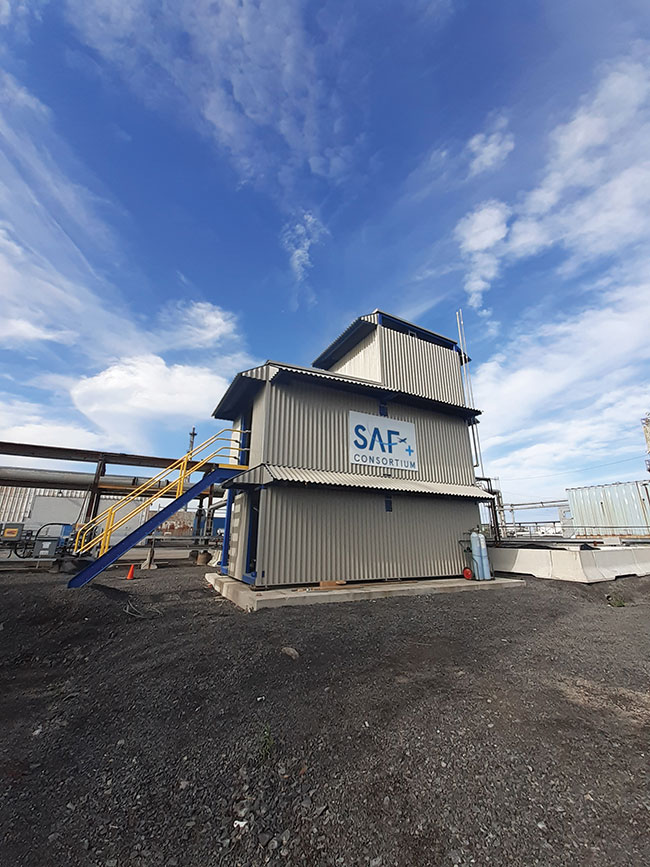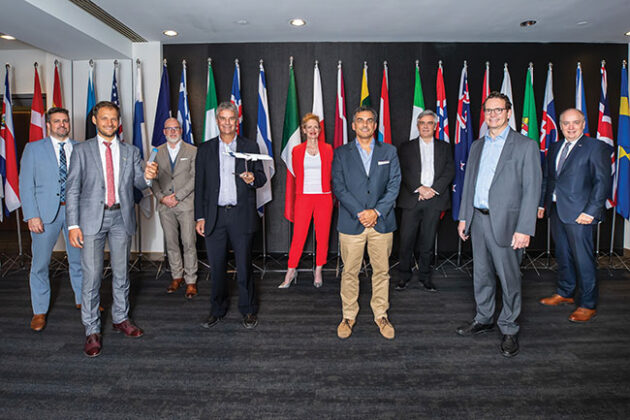
News
Fuel
Synthetic Futures
The race toward more environmentally progressive fuels for commercial aviation
July 17, 2023 By Phil Lightstone
 The SAF+ Consortium completed its pilot plant for manufacturing fungible fuels in 2021 and is currently in the development of full scale commercial plants in Quebec and other regions in Canada.
Photo: SAF+ Consortium
The SAF+ Consortium completed its pilot plant for manufacturing fungible fuels in 2021 and is currently in the development of full scale commercial plants in Quebec and other regions in Canada.
Photo: SAF+ Consortium In North America, there are 247,000 aircraft powered by fossil fuel. Electric-powered aircraft are in their infancy, but, as with electric cars, ongoing research and development will deliver more e-aircraft. Hydrogen fuel cells are currently under development both by automotive and aviation manufacturers such as Toyota and Hydroplane. Fossil fuel powered aircraft, however, delivers the best power-to-weight ratios over other power sources. No doubt, that over the course of time, research and development efforts will deliver new power technologies which can power intercontinental flights while using less resources and delivering better useful loads. But that day is not here yet and, sadly, my crystal ball is out for repair. United States aviation fuel production in 2021 was 3,969,000 barrels according to the U.S. Energy Information Administration.
There is no doubt that the environmental impact of high lead concentrations in aviation fuel is bad for our environment, people and aircraft engines. 100LL was developed in the 1970s, before engineers and business pioneers were tuned into the impacts to the environment. In Canada, as of December 31, 2021, there are 37,073 aircraft on Transport Canada’s aircraft registry, with 34,903 aircraft weighting under 12,500 pounds, most burning 100LL aviation fuel. Research indicates that there are over five million people living near airports in the U.S. (no such statistics are available for Canada). 100LL aviation fuel has a maximum of 0.56 grams of lead per litre (2.12 grams per US gallon). The EPA and the FAA are concerned about the impact of lead and are studying fossil fuel alternatives to lead.
In North America, there are roughly 146 refineries, of which there are 15 in Canada. The refined aviation fuel is either trucked or piped for distribution to Canadian airports. Clearly, there is a lot of carbon dioxide which is expelled into the atmosphere to facilitate this supply chain. Moreover, in 2017, many Canadian FBOs were compelled by Transport Canada to stop selling 100LL fuel based upon a concern of contaminated fuel from the refiner. This caused operators to change their procedures and processes to ensure that they were able to support aviation fuel from the airports which they flew into.
Electrofuels, or eFuels, can be categorized into two categories: Biofuels and hydrogen-based fuels. Biofuels are biomass-derived fuels, from plants or waste and depending on which type of biomass is used, they could lower carbon dioxide emissions by 20 to 98 per cent when compared to conventional jet fuel. The first test flight using blended biofuel was in 2008 and in 2011 blended fuels with 50 per cent biofuels were allowed in commercial flights by the FAA. In 2019, the International Air Transport Association (IATA) was planning for a two per cent penetration by 2025. Biofuels are also known as Sustainable Aviation Fuel (SAF).
There are several discussions and strategies relating to the replacement of fossil aviation fuel: Replacements fuel sources whose production and distribution reduces carbon dioxide emissions, like SAF; the move to electric aircraft; and hydrogen fuel cells. Mining carbon dioxide to manufacture aviation fuel will help with the global emissions problem.
Fungible fuel is a process that utilizes natural resources to create fuel which is completely compatible with current aviation infrastructure, including engine propulsion systems and airport fueling infrastructure. The process utilizes carbon dioxide in the air and renewable electricity to manufacture any type of fuel which the manufacturer wishes to generate. In 2021, there was more than 35 billion tons of carbon emissions worldwide. Canada contributed 1.8 per cent and the United States contributed 13.54 per cent of the total worldwide carbon emissions. Aviation contributes to 2.5 per cent of the worldwide carbon dioxide emissions. In other words, our atmosphere has an ample supply of carbon dioxide to be used as the base element in the fungible fuel process.
Sustainable Power to Liquids (PtL) or electrofuels is a family of synthetic fuels that can be manufactured utilizing several well-known chemical reactions, including the Fischer-Tropsch process. To put it simply, hydrogen is produced using renewable electricity from water and then combined with carbon dioxide, either from industrial exhaust gases or mined out of the air. The product is a drop-in replacement for legacy hydrocarbon aviation fuel of your choice with low or zero net greenhouse gas emissions. In fact, this process can manufacturer automotive as well as aviation grade fuels.
Unlike biofuels, electrofuels do not compete with foodstuffs, require cutting down forests, or require the logistics of moving large quantities of feedstock to create a biomass. Just as important, unlike biofuels, eFuel is not technically different than the conventional counterpart (100 LL or JetA) it is replacing. Electrofuels can be created to fill the tank of a classic car, an existing 18-wheeler truck, a ship, a Cessna 172, an Airbus 320, or a SpaceX rocket. Electrofuels can fit into the existing network of filling stations, clean product pipelines and tank storage systems for standalone delivery or the can be blended seamlessly with existing fuels.

The SAF+ Consortium has a goal of implementing six plants worldwide, estimating the cost of each would be around $500 million.
Fortunately, the manufacturing of fungible fuel is not a visionary concept short of delivery capabilities. Two pilot plants are operational in Quebec and in British Columbia. SAF+ Consortium (SafPlusConsortium.com) completed and operated its pilot plant in 2021 and is currently in the development of full scale commercial plants in Quebec and other regions in Canada.
Alexandru Iordan, VP of Technology at SAF+ reports: “Green hydrogen is easily produced using conventional and well known means. Co-locating our eFuel plant near large, industrialized carbon dioxide emitters, potentially near large airports, delivers the carbon dioxide that we need for our e-Fuel process, in a cost-effective manner. At production, each plant should be able to produce more than 80 million litters of fungible SAF that reduce aviation’s carbon dioxide emissions by 90 per cent compared to regular jet fuel.” SAF+’s beta plant located near Montreal can produce 750 barrels of eFuel per day.
Their production plant is forecast to manufacture 100 million liters of JetA per year depending upon SAF+’s ability to secure a block of hydroelectricity (three terawatts per year) from Quebec Hydro. With Canadian aviation consuming annually just under nine billion litres of fuel, SAF+’s approach is to scale production plants, doubling output while building plants near large Canadian airports. Based upon its current economic calculations, and its ability to fit into hydro provider tariff categories, SAF+ expects the cost of its finished product to be more expensive than current JetA fossil fuel prices. The SAF+ team is currently on the hunt for capital funding to fund the transition from pilot to production plants. While being guarded on the economic numbers, SAF+ feels that the capital cost of each plant would be more than $500 million and has a goal of implementing six plants worldwide.
In addition to capital funding requirements, are significant operating costs associated with fungible fuel. A major cost component of the process is clean electricity. According to the International Hydropower Association, Canada is the fourth largest producer of hydroelectricity in the world. In 2018, Canada had an installed hydroelectric capacity of 76,843 MW with more than one half of Canadian hydroelectricity manufactured in Quebec. New hydroelectric projects are planned to add 6,419 MW taking the total to 83,262 MW. The average cost of hydroelectricity in Quebec and BC is $0.073 and $0.126 per kWh, respectively.
I’m curious if the cost of capital could be balanced with operating costs and access to carbon dioxide sources, to one day see a plan where eFuel is manufactured at the point of consumption – airports. This would eliminate the transportation costs associated with refined fuel, as well as environmental issues associated with pipelines. In Canada, a large percentage of aviation fuel is consumed at six airports. It would make sense to implement micro fungible fuel plants at airports such as Toronto Pearson, Ottawa, Montreal, Quebec City, Halifax, Winnipeg, Calgary, Edmonton and Vancouver, to name a few. But only time will tell, as fossil oil prices increase to where an economic tipping occurs allowing eFuel to be cost effective while returning an appropriate Return on Investment to those entrepreneur’s investing into the environmental future for aviation.